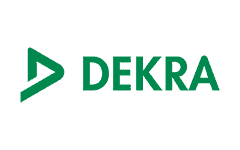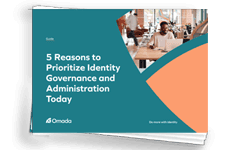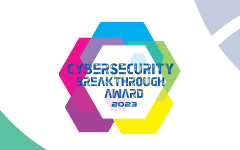Let's Get
Started
Let us show you how Omada can enable your business.
• Full-featured IGA
• Configurability without code
• Best-practice framework for solution design and deployment
• High degree of configurability
• Intelligent compliance
• Manage identities and access across hybrid platforms
• Support at every step of your IGA journey
• Personalized service package to accelerate your deployment
• Avoid common pitfalls and get value in 12 weeks
• Iterative implementation roadmap
• Standardized, well-documented best practices
• Support from Omada-certified project managers, architects, and consultants
• Stellar Customer Success Team
• Quick and professional Service Desk
• Access to ITSM system and KPI reports
• Digital self-paced and instructor-led courses
• Training on demand through our Premier Academy subscription
• Individual, role-based learning plans and certification paths
• Ensure fast and successful IGA deployment
• 5-step process with clear exit criteria
• 12 weeks time to value
• Helps support enterprise IT security
• Makes it easier to meet compliance mandates
• Automates access provisioning and enables the workforce from day 1
• Automated access provisioning and deprovisioning
• Least privilege and separation of duties policies
• Simple-to-run certification campaigns
• Access compliance status dashboards
• Cross-system certification campaigns
• 50+ audit report templates
• Identity lifecycle management
• Automatic access provisioning
• Self-service access requests
Omada provides Governance for Identity Fabric ensuring compliance regulations are met, security and efficiency around identity workflows are maintained.

A definite guide to Identity Governance and
Administration best practices. Learn how to
successfully deploy and maintain an IGA solution.

Our comprehensive Identity and Cybersecurity
glossary, featuring extensive explanations, real-life
examples, practical frameworks and everything else
you need to understand key concepts in identity and
cybersecurity.

In this Guide, Gartner has identified Omada as a
Representative Vendor in IGA. Use it to evaluate top
Identity Governance vendors and anticipate future
trends, features, and capabilities in the IGA market.

Familiarize yourself with the typical threats that
can derail a seamless legacy to cloud migration of
IGA functionality and get tips on managing them.

As part of their digital transformation, DEKRA moved
from an in-house access management solution to
a modern, cloud based Omada IGA solution.

Get practical examples and data proving the
value of IGA and learn the five key reasons you
must make it a business imperative today.

Explore our white papers on compliance, security, and
efficiency topics. Gain insights and best practices to drive
informed decisions and enhance your organizational strategy.

We are constantly adding new features to Omada
products to ensure your IGA efforts keep pace with
the ever-evolving threat landscape.

Get information about the newest Omada product
features, benefits, and use cases to ensure you get
the most from your IGA program.

Participate in interactive product demos covering
capabilities such as Delegate Access, Request
Access, Approve Access Request, and more.

Get the latest IGA trends, information, and intelligence
from renowned industry experts in Omada’s live and
on-demand webinar presentations.

A market-leading provider of identity governance
and administration solutions. Get to know us better!

At Omada, efficient teamwork creates extraordinary results.
We enable talented people to create career paths where
they can thrive, be inspired, and have fun.

Omada partners provide unmatched advisory, product
and service re-sale, and project delivery resulting in
unsurpassed customer satisfaction scores.

Don’t just take our word about the value of Omada
solutions. See what actual users think.

See what the media are reporting about our
innovative identity governance solutions.

We frequently deliver expert presentations, exhibit, and
run demos at the world’s leading security and IGA events.
Look at our upcoming schedule to see if we cross paths –
we'd love to speak with you.

Omada is a winner for a third consecutive year in the 7th
annual CyberSecurity Breakthrough Awards program.

Omada is a global market leader in Identity Governance.
Please reach out to us with questions or to get more information.

Find here legal documents governing and relating to the
provisioning of Omada Offerings - Customer Agreement, DPA, and more.
• Full-featured IGA
• Configurability without code
• Best-practice framework for solution design and deployment
• High degree of configurability
• Intelligent compliance
• Manage identities and access across hybrid platforms
• Support at every step of your IGA journey
• Personalized service package to accelerate your deployment
• Avoid common pitfalls and get value in 12 weeks
• Iterative implementation roadmap
• Standardized, well-documented best practices
• Support from Omada-certified project managers, architects, and consultants
• Stellar Customer Success Team
• Quick and professional Service Desk
• Access to ITSM system and KPI reports
• Digital self-paced and instructor-led courses
• Training on demand through our Premier Academy subscription
• Individual, role-based learning plans and certification paths
• Ensure fast and successful IGA deployment
• 5-step process with clear exit criteria
• 12 weeks time to value
• Helps support enterprise IT security
• Makes it easier to meet compliance mandates
• Automates access provisioning and enables the workforce from day 1
• Automated access provisioning and deprovisioning
• Least privilege and separation of duties policies
• Simple-to-run certification campaigns
• Access compliance status dashboards
• Cross-system certification campaigns
• 50+ audit report templates
• Identity lifecycle management
• Automatic access provisioning
• Self-service access requests
Omada provides Governance for Identity Fabric ensuring compliance regulations are met, security and efficiency around identity workflows are maintained.

A definite guide to Identity Governance and
Administration best practices. Learn how to
successfully deploy and maintain an IGA solution.

Our comprehensive Identity and Cybersecurity
glossary, featuring extensive explanations, real-life
examples, practical frameworks and everything else
you need to understand key concepts in identity and
cybersecurity.

In this Guide, Gartner has identified Omada as a
Representative Vendor in IGA. Use it to evaluate top
Identity Governance vendors and anticipate future
trends, features, and capabilities in the IGA market.

Familiarize yourself with the typical threats that
can derail a seamless legacy to cloud migration of
IGA functionality and get tips on managing them.

As part of their digital transformation, DEKRA moved
from an in-house access management solution to
a modern, cloud based Omada IGA solution.

Get practical examples and data proving the
value of IGA and learn the five key reasons you
must make it a business imperative today.

Explore our white papers on compliance, security, and
efficiency topics. Gain insights and best practices to drive
informed decisions and enhance your organizational strategy.

We are constantly adding new features to Omada
products to ensure your IGA efforts keep pace with
the ever-evolving threat landscape.

Get information about the newest Omada product
features, benefits, and use cases to ensure you get
the most from your IGA program.

Participate in interactive product demos covering
capabilities such as Delegate Access, Request
Access, Approve Access Request, and more.

Get the latest IGA trends, information, and intelligence
from renowned industry experts in Omada’s live and
on-demand webinar presentations.

A market-leading provider of identity governance
and administration solutions. Get to know us better!

At Omada, efficient teamwork creates extraordinary results.
We enable talented people to create career paths where
they can thrive, be inspired, and have fun.

Omada partners provide unmatched advisory, product
and service re-sale, and project delivery resulting in
unsurpassed customer satisfaction scores.

Don’t just take our word about the value of Omada
solutions. See what actual users think.

See what the media are reporting about our
innovative identity governance solutions.

We frequently deliver expert presentations, exhibit, and
run demos at the world’s leading security and IGA events.
Look at our upcoming schedule to see if we cross paths –
we'd love to speak with you.

Omada is a winner for a third consecutive year in the 7th
annual CyberSecurity Breakthrough Awards program.

Omada is a global market leader in Identity Governance.
Please reach out to us with questions or to get more information.

Find here legal documents governing and relating to the
provisioning of Omada Offerings - Customer Agreement, DPA, and more.
Home / What is an Access Risk?


Access Risk in Identity Governance and Administration (IGA) refers to the potential threats or vulnerabilities to organizational identity security that emerge because of improper or excessive access to systems, data, or resources in an IT infrastructure. It focuses on identifying and managing situations where users (employees, contractors, partners, vendors, and applications) have inappropriate permissions that could lead to security breaches, data leaks, fraud, or compliance violations.
Any scenario listed below may be characterized as an Access Risk:
Organizations that do not follow the principle of least privilege allow users to have more access rights to systems and resources than are necessary for them to perform their job functions. An example of excessive permissions would be an organization allowing an employee on the HR team to have access to financial systems without justification.
Conflicts surface when a single user has access to multiple job roles that should be separated to prevent fraud or errors. An employee having the capacity to both approve payments and modify vendor bank account details would be an example of this type of Access Risk.
Accounts that remain active even after an employee leaves the organization, potentially leading to misuse.
Accounts that are no longer in use and still exist in the system. If the accounts were to be compromised, this would pose a security risk to the organization.
Granting access to unauthorized users, either unintentionally or due to tools misconfiguration.
Users with elevated permissions abusing their access for unauthorized actions.
Failure to enforce user access policies can lead to violations of regulatory frameworks like SOX, GDPR, HIPAA, etc.
Organizations can use a range of approaches within their IGA solution to manage Access Risk in their IT architectures. These include:
This method refers to the restriction of access to parts of a business network based on a person’s defined role within an organization. Effective RBAC enables organizations to grant users access only to the resources necessary to perform their roles, whether that is based on their department, seniority, title, or some other criteria.
This process ensures that users’ access rights remain appropriate and aligned with their current roles. Organizations can build on periodic access reviews by establishing feedback mechanisms for users and administrators to report issues or suggest improvements to their IGA framework.
Deploy an internal control mechanism that enables the division of tasks and responsibilities among multiple individuals to reduce the risk of error, fraud, or malicious activity. This ensures that no single individual has control over all aspects of any critical process, thereby engaging fraud prevention and limiting opportunities for mistakes or intentional wrongdoing.
Managing the entire lifecycle of user, machine, and AI-generated identities within an organization dramatically mitigates Access Risk. This includes processes and policies to initiate, maintain, and delete user identities securely and efficiently. This ensures effective control over user onboarding (provisioning), changes, and offboarding (de-provisioning).
Mandated reviews, attestations, or re-certifications enable managers and system owners to periodically validate information held in the IGA system. Modern IGA solutions offer both out-of-the-box certification campaigns and customizable options that enable administrators to define their own processes.
Users with enhanced permissions are prime targets for attackers due to their extensive access to vital systems and sensitive data. PAM enables administrators to effectively control, monitor, and protect accounts with privileged status and mitigate this risk.
By addressing Access Risk effectively, organizations can improve security posture, enforce compliance, and reduce vulnerabilities associated with identity governance and administration.
Omada has developed and defined best practices for managing Access Risk in IdentityPROCESS+. Following IdentityPROCESS+ enables organizations to control the granting of access rights and manage risk while ensuring that they do not violate any security and compliance policies such as SoD. Learn more.



